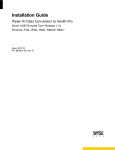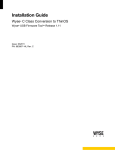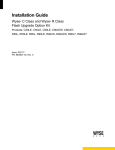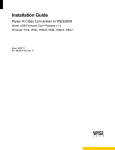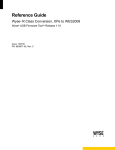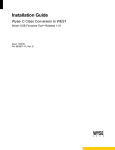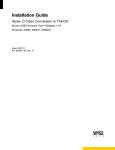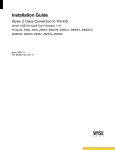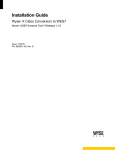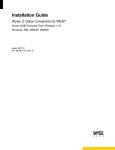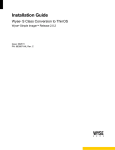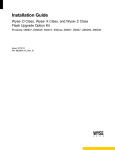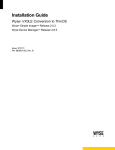Download Dell Wyse RX0L ThinOS
Transcript
Installation Guide Wyse R Class Conversion to ThinOS ® Wyse® USB Firmware ToolTM Release 1.12 Products: R50L, R90L, R90LW, R90L7 Issue: 032911 PN: 883887-20L Rev. B Copyright Notices © 2011, Wyse Technology Inc. All rights reserved. This manual and the software and firmware described in it are copyrighted. You may not reproduce, transmit, transcribe, store in a retrieval system, or translate into any language or computer language, in any form or by any means, electronic, mechanical, magnetic, optical, chemical, manual or otherwise, any part of this publication without express written permission. End User License Agreement (“License”) A copy of the Wyse Technology End User License Agreement is included in the software and provided for your reference only. The License at http://www.wyse.com/license as of the purchase date is the controlling licensing agreement. By copying, using, or installing the software or the product, you agree to be bound by those terms. Trademarks The Wyse logo and Wyse are trademarks of Wyse Technology Inc. Other product names mentioned herein are for identification purposes only and may be trademarks and/or registered trademarks of their respective companies. Specifications subject to change without notice. Restricted Rights Legend You acknowledge that the Software is of U.S. origin. You agree to comply with all applicable international and national laws that apply to the Software, including the U.S. Export Administration Regulations, as well as end-user, end-use and country destination restrictions issued by U.S. and other governments. For additional information on exporting the Software, see http://www.microsoft.com/exporting. Ordering Information For availability, pricing, and ordering information in the United States and Canada, call 1-800-GET-WYSE (1-800-438-9973) or visit us at http://www.wyse.com. In all other countries, contact your sales representative. Contents 1 Introduction 1 Kit Contents 1 Wyse Technical Support 2 Related Documentation and Services Wyse Online Community 2 2 2 Converting Wyse R Class to ThinOS 3 Requirements 3 Procedures 4 Troubleshooting 9 USB Keys - Troubleshooting Boot Issues 9 SanDisk Cruiser Flash Drives - Troubleshooting Partition Issues 9 iv Contents This page intentionally blank. 1 Introduction This guide provides the instructions you need to install and use Wyse® USB Firmware ToolTM to convert the following Wyse R class thin clients to ThinOS: • R50L • R90L • R90LW • R90L7 Kit Contents The conversion kit includes: • 1 Year ThinOS Maintenance (you will receive an email from Wyse or your reseller with full instructions) • Conversion Software Assembly CD-ROM • Wyse Conversion Labels (you must attach a Wyse label to each converted thin client) Figure 1 Kit contents (items may look different) The Conversion Software Assembly CD-ROM contains: • A PDF of this Reference Guide • Wyse USB Firmware Tool Release 1.12 • R Class ThinOS Conversion Image folder containing the following files: · bios.img · cmos.img · commandsXml.xml · par1.img 2 Chapter 1 Wyse Technical Support To access Wyse technical resources, visit http://www.wyse.com/support. If you still have questions, you can submit your questions using the Wyse Self-Service Center (on the Wyse.com home page, go to Support > Knowledge Base > Home tab) or call Customer Support at 1-800-800-WYSE (toll free in U.S. and Canada). Hours of operation are from 6:00 A.M. to 5:00 P.M. Pacific Time, Monday through Friday. To access international support, visit http://www.wyse.com/global. Related Documentation and Services Fact Sheets containing the features of hardware products are available on the Wyse Web site. Go to http://www.wyse.com/products/hardware, click the link for your hardware product, and then click the link for the Fact Sheet. Administrator and other documentation for your thin client model are available at: http://www.wyse.com/manuals. Wyse Online Community Wyse maintains an online community where users of our products can seek and exchange information on user forums. Visit the Wyse Online Community forums at: http://community.wyse.com/forum. 2 Converting Wyse R Class to ThinOS This chapter includes the requirements and procedures you need to install and use Wyse® USB Firmware ToolTM to update your thin client to ThinOS firmware. Tip The purpose of the Wyse USB Firmware Tool is to configure a bootable USB key for device firmware. In the following procedures, you will create a configured USB key containing the firmware contents that you need, and then boot from this configured USB key on appropriate product and flash size devices to push the contents of the USB key onto these target devices. Requirements • Windows XP Professional SP3, Windows 2003 Server, Windows 7 Enterprise (32-bit), or Windows 7 Ultimate (64-bit) • USB key size should be 4 GB or larger (up to 16 GB tested—see "USB Keys Troubleshooting Boot Issues") Caution During the USB key configuration process the USB key will be reformatted. 4 Chapter 2 Procedures Complete the following procedures as an administrator (administrator privileges are required). Step 1: Copy the R Class ThinOS Conversion Image Folder to Your Local Hard Drive Navigate to the R Class ThinOS Conversion Image folder (contained on the Conversion Software Assembly CD-ROM) and copy it to your local hard drive. Step 2: Install Wyse USB Firmware Tool 1.12 1. Navigate to the Wyse USB Firmware Tool v1.12_GA.exe (contained on the Conversion Software Assembly CD-ROM) and double-click it to execute the file and open the WinZip Self-Extractor dialog box. Figure 2 Extract files to your hard drive (C:\USBFT112) 2. Enter C:\USBFT112 in the Unzip to folder box, and then click Unzip to extract all files from the Wyse USB Firmware Tool v1.12_GA.exe file into the C:\USBFT112 directory. The default directory for the extracted files is Wyse USB Firmware Tool. Caution It is not recommended to use your desktop for the destination directory as there are several files that will be extracted from the .exe file. 3. Create a shortcut on the desktop for the Wyse USB Firmware Tool.exe file. Step 3: Use Wyse USB Firmware Tool to Configure a Single USB Key to Install Firmware 1. Double-click the shortcut to run the tool and open the Wyse USB Firmware Tool wizard (the welcome page provides the product version and description, and a link to view the Wyse end user license agreement). Caution For the Windows 7 Enterprise 32-bit operating system, be sure to right-click on Wyse USB Firmware Tool.exe, select Properties, and enable the Run this program as an administrator option on the Compatibility tab). Converting Wyse R Class to ThinOS Figure 3 5 Wyse USB Firmware Tool wizard 2. Click Next to open the Select an Option dialog box. Figure 4 Configuration options 3. Select the Configure a single USB key to Copy or to Update firmware option, and then click Next to open the Select the Configuration dialog box. Figure 5 Update firmware options 4. Select the WTOS / Xenith OS type option. 5. Select the Update Firmware operation to perform option. Note that all three contents options are selected by default (OS Image, BIOS, and CMOS). 6. Click Next to open the browse dialog box. 6 Chapter 2 Figure 6 Browse for image file 7. Click Browse. Figure 7 Browse to select commandsXml.xml 8. Navigate to the R Class ThinOS Conversion Image folder on your hard drive (this is the location you selected in "Step 1: Copy the R Class ThinOS Conversion Image Folder to Your Local Hard Drive"), click on the commandsXml.xml file to select it (you may need to select the All Files option from the Files of Type box to display the commandsXml.xml file for selection), and then click Open. Caution Do not use the commandsXml.xml file directly from the Conversion Software Assembly CD-ROM. 9. In the browse dialog box, click Next to open the Prepare the USB Drive dialog box. Figure 8 Prepare USB drive Converting Wyse R Class to ThinOS 7 10.Select the USB key onto which you want the configurations (you can use Refresh as needed to recognize an inserted USB key), and then click Next. The progress bars show the overall (formatting and configuration) progress and task progress. 11. After configuration, click Finish to close the wizard and then remove the configured USB key for use (you will use the configured USB key on your target devices). Caution Before using any configured USB key on a target device (to push firmware), you must configure the target device to boot from the configured USB key as described in "Step 4: Use the Configured USB Key to Install Firmware on Each Thin Client." Step 4: Use the Configured USB Key to Install Firmware on Each Thin Client On each thin client you want to convert, use the one-time boot menu to configure it to boot from the configured USB key (the one-time boot menu will not modify your default BIOS configurations). To enter and use the one-time boot menu: 1. Attach the configured USB key to the thin client (be sure it is shut down and disconnected from any network). 2. Power on the device while pressing and holding the P key during boot. When prompted for a boot option, select the USB HDD option for your device (usually option 3 in the list of boot options) and press Enter. 3. Follow the process prompts. Tip When booting a target device from the configured USB key (containing the contents to be pushed to a target device), you will be prompted to continue with the push process (to continue, type y and press Enter). Once the push process is complete, you will be prompted to reboot (to reboot, press Enter and remove the USB key). Caution During the Critical Operation in Progress message, do not interrupt the process. Step 5: Verifying Thin Client Operation After the thin client reboots, you can verify that your general client information is correct. 1. After your thin client reboots, the System Information dialog box appears on the desktop. 2. On the General tab of the System Information dialog box, verify the following: • System Version is 7.0.0_30. 3. Click OK to close the System Information dialog box. The thin client is ready for operation and setup by an administrator. Tip For more information, see Administrators Guide: Wyse ThinOS™. Administrator and other documentation for your thin client model are available at: http://www.wyse.com/manuals. 8 Chapter 2 Step 6: Attach a Wyse Conversion Label on Each Converted Thin Client The conversion kit is supplied with Wyse Conversion Labels that must be attached to each thin client as shown in Figure 9. Be sure you have purchased the amount of labels you need. Caution Failure to install the labels may cause delays in service and support. The serial number must be given to a Customer Support Technician to validate entitlement to support and service from Wyse. Failure to do so will result in the original operating system being loaded on the device and is in breach of your license agreement. Figure 9 Placement of Wyse label Step 7: Obtain a Firmware Update After converting your thin clients, you must use your 1 Year ThinOS Maintenance (you should have received an email from Wyse or your reseller with full instructions) to obtain any available firmware update (if you did not receive this email, contact your reseller). Tip If you are unfamiliar with updating firmware on your Wyse ThinOS thin client, refer to Wyse Knowledge Base Solution #10566 (go to the Wyse Knowledge Base at http://www.wyse.com/kb and search for 10566). Warning Wyse Thin Client Software Maintenance is required to be eligible to receive new versions of thin client software and subsequent releases of corresponding documentation and tools. Wyse announces new versions of software through the WyseView newsletter. To receive notification of available software updates, customers must subscribe to the free WyseView newsletter at http://www.wyse.com/wyseview. Use of the Software on more than one device requires that you first purchase from Wyse additional copies of, or licenses to, the Software. Contact your local Wyse distributor or Wyse Inside Sales at 1-800-800-9973 option 1 or 1-408-473-1200 option 1. Converting Wyse R Class to ThinOS 9 Troubleshooting This section contains general troubleshooting information. USB Keys - Troubleshooting Boot Issues Due to different manufacturing processes on USB keys (and the variety of them), not all brands have been tested with the Wyse USB Firmware Tool. If you experience problems booting from a configured USB key, it is recommended that you try a different brand of USB key. The following list of USB keys have been successfully tested with the Wyse USB Firmware Tool: • Kingston Data Traveler 4 GB • Kingston Data Traveler 8 GB • SanDisk Cruzer micro 4 GB • SanDisk Cruzer micro 8 GB • SanDisk Cruzer micro 16 GB • Transcendent 4GB SanDisk Cruiser Flash Drives - Troubleshooting Partition Issues Problem: How can I properly use a SanDisk Cruiser flash drive to image supported devices using the Wyse USB Firmware Tool? (KB17735) Solution: SanDisk flash drives come with support for U3 (for details on U3, see http://www.u3.com). When you initially use these drives, you are prompted to select the use for the drive: Apps and Storage or only Storage. If you select the Apps and Storage option, the drive will create two partitions, one of which is identified as a CD and is a read only partition. This partition sometimes prevents the Wyse USB Firmware Tool to properly prepare the USB key for imaging a device. To resolve this problem you can do one of the following: • Go to http://www.sandisk.com, search in the SanDisk Knowledge Base for document 2550, and then follow the instructions in the documentation. • Go to http://www.sandisk.com/DriverDownload/driverList.asp, select USB Flash Drives from the Select Product Type list, click Find Driver, select U3 LaunchPad Remover, click Continue, and then download and use the U3 Launchpad Remover according to the instructions. Installation Guide Wyse® R Class Conversion to ThinOS Issue: 032911 Written and published by: Wyse Technology Inc., March 2011 Created using FrameMaker® and Acrobat®














